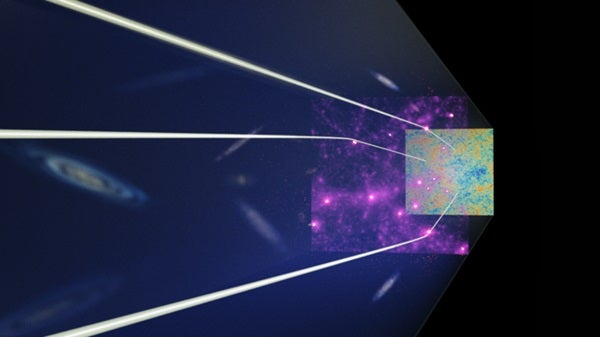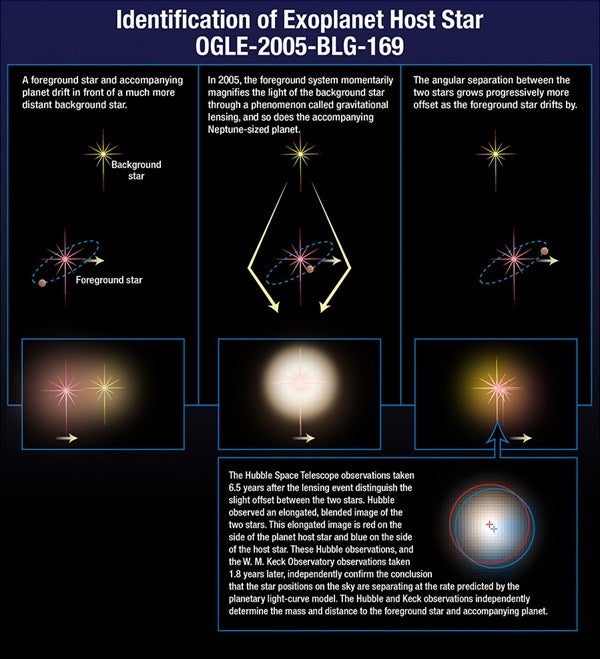The static speed of light assures that astronomers see faraway galaxies not as they are, but as they existed long ago. The same is true about the matter (regular or dark) that surrounds these ancient galaxies.
Astronomers recently used this knowledge — as well as a cosmic signal sent out shortly after the Big Bang — to map how dark matter was distributed around galaxies some 12 billion years ago. In short, they found the dark matter was less ‘clumpy’ than expected, which, if confirmed, would suggest that many accepted models of cosmology are due for revisal.
The new findings are presented in a study published Aug. 1 in Physical Review Letters.
Back to the beginnings
Though it’s tricky to measure “invisible” matter, the typical approach involves two galaxies, one in the foreground and one in the background. According to Einstein, the immense gravity of the foreground galaxy actually warps the fabric of space-time near it. Thus, as light from the background galaxy travels past the foreground galaxy, it gets bent, as if by an optical lens. This results in the background galaxy being both heavily distorted and magnified, a phenomenon called gravitational lensing.
Because the background galaxy (or “source galaxy”) appears more heavily distorted when the foreground galaxy (“lens galaxy”) has a lot of mass, astronomers can analyze the distortions to determine the distribution of matter — including dark matter — around the lens galaxy.
But this method only works when the source galaxy is bright enough to actually shed light on the lens galaxy. And because extremely distant galaxies are extremely faint, astronomers have so far been unable to assess dark matter in galaxies from before around 8 billion to 10 billion years ago. This has left them largely in the dark about the true structure of the early universe.
Aiming to overcome this obstacle, a team of astronomers recently altered the approach. Instead of using two galaxies, they opted to use a more distant light source in place of a source galaxy: the cosmic microwave background (CMB), emitted when the universe was just 300,000 years old.
“It was a crazy idea,” Masami Ouchi, a study author and astronomer at the University of Tokyo, said in a press release. “No one realized we could do this.”
“Most researchers use source galaxies to measure dark matter distribution from the present to 8 billion years ago,” added Yuichi Harikane, a study author and astronomer at the University of Tokyo. “However, we could look further back into the past because we used the more distant CMB to measure dark matter. For the first time, we were measuring dark matter from almost the earliest moments of the universe.”
Illuminating dark matter
To employ their new approach, the astronomers selected 1.5 million galaxies — all seen as they were about 12 billion years ago — to collectively serve as the gravitational lens. And with the more distant CMB serving as the background source light, the team was able to measure how dark matter was dispersed around these lens galaxies.
“I was happy that we opened a new window into that era,” said Hironao Miyatake, another study author and astronomer at Nagoya University, in a press release. “12 billion years ago, things were very different.”
According to the team, their results could challenge prevalent theories of cosmology, including the idea that tiny variances in the CMB are what initially led to the earliest clumps of matter, which ultimately formed into stars and galaxies. As it turns out, the team says, the universe was much more homogeneous in its early years than previously thought.
“Our finding is still uncertain,” Miyatake said in a press release. “But if it is true, it would suggest that the entire model is flawed as you go further back in time. This is exciting because if the result holds after the uncertainties are reduced, it could suggest an improvement of the model that may provide insight into the nature of dark matter itself.”
Ultimately, the team says that their approach will provide astronomers with more accurate measurements of the amount and distribution of dark matter in ancient galaxies. It will also enable astronomers to explore other aspects of the early universe.
“One of the strengths of looking at the universe using large-scale surveys, such as the ones used in this research, is that you can study everything that you see in the resulting images, from nearby asteroids in our solar system to the most distant galaxies from the early universe,” said Michael Strauss, a professor of astrophysical sciences at Princeton University who was not involved in the research, in a press release. “You can use the same data to explore a lot of new questions.”











